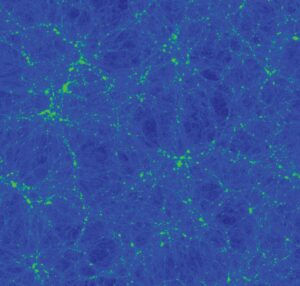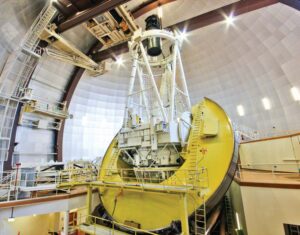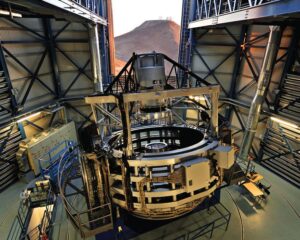Are dark matter and dark energy real? How UWA is teaming up with leading Australian and European institutions to unlock two of the most compelling mysteries in contemporary physics.

ESO’s Paranal Observatory—located in Chile’s Atacama region—with the VISTA enclosure visible in the lower right of the image. VISTA is the largest survey telescope in the world and it is dedicated to mapping the sky at near-infrared wavelengths. Credit: ESO/B. Tafreshi (twanight.org).
Across Australia, Europe and the Americas, more than 100 astrophysicists are approaching the end of a colossal project. For more than a decade, they have been mapping the lace-like structure of the nearby Universe by painstakingly calculating the distances to more than 300,000 galaxies. Along the way, the researchers have made global headlines by measuring the slow death of the Universe, showing what happens when galaxies smash together, and searching for galaxy groups similar to our own Milky Way-Magellanic Cloud system.
This collaboration is known as the Galaxy And Mass Assembly (GAMA) survey and has been led for the past seven years by Professor Simon Driver of the UWA node of the International Centre for Radio Astronomy Research (ICRAR).The project combines data from a number of ground and space-based facilities including the Anglo-Australian Telescope (AAT), the European Southern Observatory’s Visible and Infrared Survey Telescope for Astronomy (VISTA), NASA’s Galaxy Evolution Explorer (GALEX) and Wide-field Infrared Survey Explorer (WISE), and the Herschel Space Observatory, built and operated by the European Space Agency (ESA).
Now, with a $1.4 million investment, UWA is driving two international consortiums to operate major observational facilities—the Anglo-Australian Telescope in New South Wales and the 4 Metre Optical Spectroscopic Telescope (4MOST) in northern Chile, a 60 million euro upgrade to the VISTA telescope.
Together these facilities, and the surveys they conduct, will provide detailed measurements of the 3D distribution of millions of galaxies, directly supporting the science programs of upcoming NASA and ESA space missions, as well as helping to lift the lid on arguably the most compelling mysteries in physics today. What are dark matter and dark energy?
Dark matter cannot be seen directly but is thought to account for roughly 27 per cent of the Universe, while ordinary matter makes up just 5 per cent, and the remaining 68 per cent is attributed as dark energy.
Although dark matter itself is invisible, we can see its gravitational effect through the creation of strongly clustered patterns and groupings in the galaxy distribution.Without it, galaxies would be more uniformly distributed throughout the Universe and the lace-like structure less apparent. Conversely, on the very largest scales, dark energy drives galaxies apart, opposing the influence of the dark matter and helping to create dark voids or large gaps in the galaxy distribution.

This image is from a simulation designed to produce synthetic WAVES and DEVILS galaxy evolution surveys. It shows the large scale distribution of dark matter and the lace-like structure of the Universe in a cosmological volume of ~300 Mpc.

This is an image from a simulation showing dark matter distribution in a cosmological volume of ~60 Mpc. The simulation is used to study how satellite galaxies cluster around primary galaxies and is helping researchers better understand how well dark matter can be measured in low mass galaxy groups in the real Universe.
Within these international consortiums, UWA will head up two studies; the DEVILS survey (led by Dr Luke Davies on the AAT) and the WAVES survey (led by Professor Simon Driver on 4MOST).These studies will pursue two new avenues. Firstly, they will investigate how the patterns in the galaxy distribution have evolved over the past eight billion years, and secondly, they will discern the finer secondary structures embedded within the nearby galaxy distribution. These patterns, their evolution, and fine detail, are driven almost entirely by the underlying dark matter.
These partnerships involve several Australian and European universities with the aim of measuring optical spectra for more than 30 million galaxies over the next decade. Another of UWA’s critical roles will be to develop the software pipeline needed to extract the distance measurements from the spectra.These spectra will also be used by the 4MOST consortium to explore the nature of black holes, the evolution of massive clusters of galaxies and to pin down the strength of dark energy.
Alongside the mapping effort is the development of advanced statistical analysis tools led by Dr Aaron Robotham, and numerical simulations led by Associate Professor Chris Power, also from ICRAR/UWA. These massive simulations use the Pawsey supercomputing facilities to model the gravitational interactions of billions of particles in large volumes of space over time.

With a 3.9 metre mirror, the Anglo-Australian Telescope (AAT) is the largest optical (visible light) telescope in Australia. Credit: Ángel R. López Sánchez, Australian Astronomical Observatory.

The VISTA telescope. Following its upgrade and rebirth as 4MOST, using technologies developed in Australia, it will supersede the AAT as the world’s premier spectroscopic survey facility. Credit: G. Hüdepohl (atacamaphoto.com)/ESO.
The combination of these state-of-the-art simulations, with our two observational approaches—sampling the nearby Universe in more detail and extending deeper into the Universe—will place much needed astrophysical constraints on the dark matter problem. A problem which has stymied the physics community for over four decades and led to billion dollar investments in facilities such as those housed in CERN in Switzerland, and at Brookhaven in the US. Potentially these observations have the possibility to rule out some of the proposed particles and to distinguish between dark matter as missing mass—potentially detectable as exotic new particles—or as a missing effect that is only detectable through astrophysical measurements.
This latter distinction is absolutely critical and these observations may finally be able to answer two of the biggest questions keeping scientists awake at night. Are dark matter and dark energy real, or simply a failure in our current understanding of gravity?
By the numbers
300,000Galaxies studied by the GAMA survey
2 MILLIONGalaxies to be studied as part of the DEVILS and WAVES surveys
30 MILLIONGalaxies to be studied by the full 4MOST Consortium
27%Proportion of the Universe made up of dark matter
$1.4 MILLIONUWA investment in the 4MOST and AAT partnerships
$3.0 MILLIONFunds raised by UWA researchers to construct the Australian European Southern Observatory Fibre Positioner to be installed on 4MOST
$120 MILLIONInvestment by the Federal Government into the European Southern Observatory over the next 10 years
